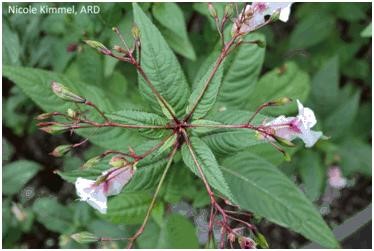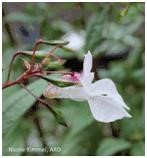Family – Impatiens Balsaminaceae
Life Cycle – Summer Annual
Habitat – Requires moist soils and some disturbance to establish (uprooted trees, flooding). It thrives best in the nutrient rich soils of disturbed riparian areas and wet woodlands. It is frost sensitive and intolerant of drought.
Key Features
- Bamboo-liker stem, smooth, usually hollow and jointed.
- Red tinged stem and leaves
- Sharply serrated leaves
- Opposite or whorled leaves, usually 3.
- Exploding fruit capsules
Identification
Stems are smooth, hallow, hairless, tinged red-purple and can be easily broken. The plant can grow up to 1-3 meters tall and there may be some branching.
Leaves are lance shaped or elliptic with pointed tips and rounded bases, and approximately 6-15cm in length. The leaves are stalked and have sharp serrated edges. Leaves occur opposite or in whorls of three, leaf size depends on how tall the plant it.
Flowers are large, 2.5-4cm long. They come in shades of pink purple or even white. Flowers occur 5-10 together in racemes on long stems borne in the upper leaf axils. Flowers have 5 petals and are bi-laterally symmetrical. The upper petals forms a hood over the reproductive structures and the lower petals form a platform for landing insects.
Seed capsules are 1.5-3.5 cm long and up to 1.5cm wide and contain up to 16 seeds which are 4-7mm long and 2-4mm wide. Seeds require cold stratification before germination. Seed capsules may produce a small number of seeds however; when the capsule explodes it can send seeds up to 7m away from the original plant.
Prevention
The most common way this plant is spread is through ornamental plantings. Do not purchase or grow Himalayan balsam in your gardens. Seeds can be spread by movement of riparian soils and sediment from the bottoms of water courses of infested areas. Remedy soil disturbance in suitable habitats. Any control work on infested stands must be done before flowering.
 |
 |
